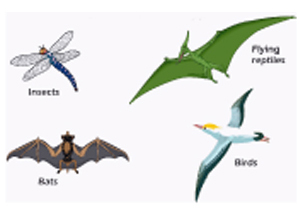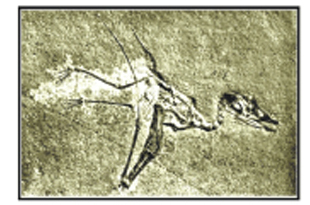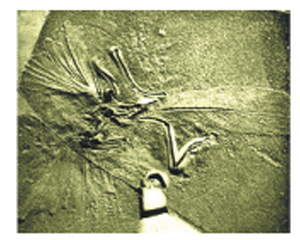FLIGHT
WHEN man first succeeded in making a machine that could fly it was only after a good deal of thinking and planning. Right from the start aircraft were designed to fly — they were not adapted motor cars! Indeed, no one in their right mind would dream of trying to make an aircraft by adding wings to a car. Strangely, evolutionists believe that flying animals have been adapted from non-flying ancestors by gradual chance processes over millions of years.

Aircraft are designed for flight
FOUR TIMES
Flight supposedly evolved four times in the animal kingdom — in flying insects, flying reptiles, bats and birds. Therefore, the origin of flight should be a good 'test case' for evolution. However, in each of these cases we find clear evidence of special design for flight. Take flying insects, which we are told were the first creatures to 'learn to fly' some '300 million years ago.' David Attenborough thinks insects may have grown wings to save them having to crawl back down the stems of plants.1 How wings could grow on a non-flying insect he does not explain. One well-known insect with wings — the dragonfly — is a very efficient flier besides having very beautiful wings, and dragonfly fossils show they have never been any different, except that some were larger with wing spans of up to 30cm (2.5 feet)!2

The origin of flight should be a good 'test case' for evolution.
FLYING REPTILES
The extinct flying reptiles show an even clearer case of special design. David Attenborough says that some of the reptiles during the time of the dinosaurs 'grew an elongated digit on each foreleg which supported sail-like flaps of leathery skin, and took to the air'.3 However, their fossil remains show that they were certainly not dinosaurs with wings added. Their whole structure was designed for flight. In the case of the Pteranodon, whose wing span sometimes reached 17 metres (50 feet), the wing bones were hollow, and criss-crossed with tiny braces, just like the structure of the modern jumbo jet! There we have lightness and strength combined — ideal for a flying creature. All the fossils of flying reptiles show fully developed wing bones. There are no fossils showing the fourth digit gradually growing longer, or that the wings developed from the forelegs of ground dwelling reptiles.
BATS
Bats are the only flying mammals and are equipped for flight in several special ways. Four of the digits are elongated to support the light, but strong membrane, which is equipped with muscles and elastic fibres to keep it taut.

Fossils of flying reptiles show nob evidence for evolution.
The leading edge of the wing is supported by a special muscle which, when contracted in flight, produces a leading edge flap to the wing, a well-known device to assist lift in aircraft. There is no fossil evidence that bats evolved from non-flying ancestors, as evolutionists John E. Hill and James D. Smith have admitted, 'All fossil bats, even the oldest, are fully developed bats, and so they shed little light on the transition from their terrestrial ancestors.4

Fossil of Archaeopteryx
Last, but not least, bats have their amazing 'sonar' system enabling them to navigate and catch insects in total darkness. Pages could be written describing the special equipment bats are provided with to send out and receive these sound-echoes. In spite of all this, evolutionists believe bats are modified tree dwellers!
BIRDS
Finally, we consider the birds, believed by evolutionists to have evolved from reptiles (though not flying reptiles). There is no convincing fossil evidence for this theory. The famous Archaeopteryx, discovered in 1861, cannot be a 'missing link' since the bones of true birds are found in rocks which are older on the evolutionists' own dating system, and more recent claims to have found 'feathered dinosaurs' do not stand up to close examination.5 But wings and feathers are only a small part of the vast difference between reptiles and birds. The whole anatomy of birds is fitted for flight with hollow bones and a specialised respiratory system. It is difficult to see how a transitional stage would be fit enough to survive.
CREATED FOR FLIGHT
The evidence suggests that all flying creatures, living and extinct, were created for flight, and are powerful evidence for special creation. To believe they evolved requires a lot of faith. 'God created... every winged bird [literally 'winged creature'] according to its kind. And God saw that it was good' (Genesis 1:21). Flying creatures have been flying since they were created by God in the beginning.
REFERENCES
- Life on Earth, Fontana/Collins. 1979, p. 72
- See Insects and Evolution CRT Factsheet No. 31.
- Reference 1, p. 154
- Bats: a Natural History Bristish Museum 1984, p. 33.
- See Feathered Dinosaurs? CRT Factsheet No. 38.
Factsheets published regularly by Creation Resources Trust, PO Box 3237, Yeovil, BA22 7WD.
(Registered Charity No. 1016666) www.c-r-t.co.uk © 2003

